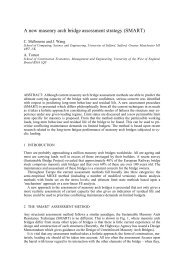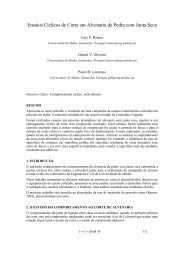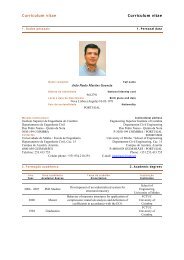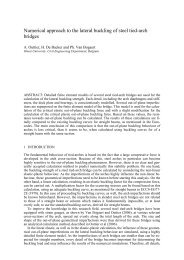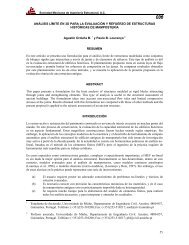an orthotropic continuum model for the analysis of masonry structures
an orthotropic continuum model for the analysis of masonry structures
an orthotropic continuum model for the analysis of masonry structures
Create successful ePaper yourself
Turn your PDF publications into a flip-book with our unique Google optimized e-Paper software.
TNO-95-NM-R0712 1995 15Ñ The normal stress-strain response in <strong>the</strong> x-direction shows <strong>an</strong> implicit coupling between normalstress <strong>an</strong>d shear stress. This is also in opposition with <strong>the</strong> Þxed crack <strong>model</strong>, where nocoupling is found, but also characterizes <strong>the</strong> rotating crack <strong>model</strong>, though to a less extent;Ñ The normal stress-strain response in <strong>the</strong> y-direction shows <strong>the</strong> implicit coupling between normalstresses. This is also in opposition with <strong>the</strong> Þxed crack <strong>model</strong>, where no coupling isfound, but also characterizes <strong>the</strong> rotating crack <strong>model</strong>, though to a less extent. The largeramount <strong>of</strong> coupling found in <strong>the</strong> proposed <strong>model</strong> is due to <strong>the</strong> isotropic s<strong>of</strong>tening.2.3.2 Orthotropic material behaviourThe <strong>orthotropic</strong> behaviour <strong>of</strong> <strong>the</strong> <strong>model</strong> is now discussed in a single element test under pure uniaxialtension. The material properties given in Table 2 are assumed, in which <strong>the</strong> y-direction is penalizedby a factor 2. Two different fracture energies are considered <strong>for</strong> <strong>the</strong> y-direction: G fx /2 <strong>an</strong>d500 × G fx (almost ideally plastic behaviour).Table 2 - Material properties (<strong>orthotropic</strong> - α = 1.0)Material propertiesE x 10000 N/mm 2 E y 5000 N/mm 2ν xy 0.2 G xy 3000 N/mm 2f tx 1.0 N/mm 2 f ty 0.5 N/mm 2G fx 0.0002 N.mm/mm 2 G fyCase 1 Case 20.0001 N.mm/mm 2 0.1 N.mm/mm 2The values chosen <strong>for</strong> <strong>the</strong> material properties conÞrm <strong>the</strong> fact that completely different behaviouralong <strong>the</strong> two material axes c<strong>an</strong> be reproduced, see Fig. 12. In <strong>the</strong> Þrst example isotropic s<strong>of</strong>teningis considered. This me<strong>an</strong>s that <strong>the</strong> ratio <strong>of</strong> <strong>the</strong> material strength along <strong>the</strong> material axes is const<strong>an</strong>t,see Fig. 13a, during <strong>an</strong>y load history. It is import<strong>an</strong>t that this deÞnition is not confounded with <strong>the</strong>deÞnition <strong>of</strong> isotropy used in damaged <strong>model</strong>s. Isotropic s<strong>of</strong>tening is related to <strong>the</strong> current yieldstrength values <strong>an</strong>d, not necessarily, to all <strong>the</strong> components <strong>the</strong> current stress vector. When all <strong>the</strong>fracture energy is exhausted a no-tension material is recovered, see Fig. 14a. In <strong>the</strong> second exampleideally plastic behaviour in <strong>the</strong> y-direction is considered. This me<strong>an</strong>s that <strong>the</strong> ratio <strong>of</strong> <strong>the</strong> materialstrength along <strong>the</strong> material axes ( f tx / f ty) tends to zero, see Fig. 13b. The yield surface is onlyallowed to shrink along <strong>the</strong> x-axis, see Fig. 14b.


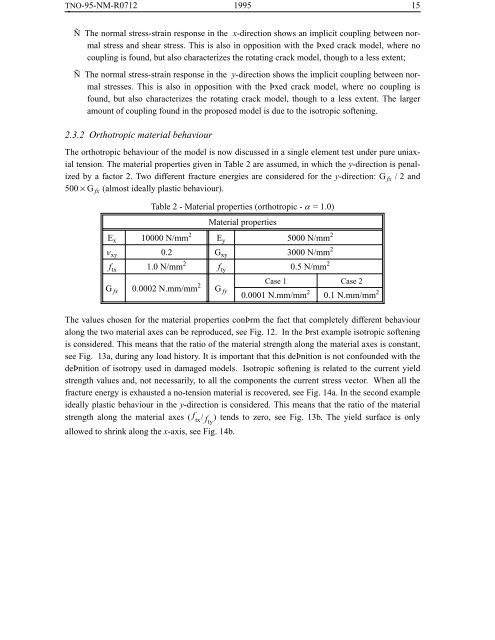
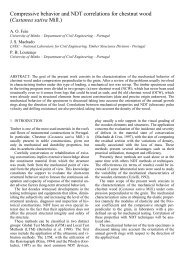
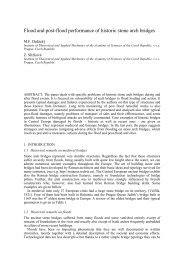
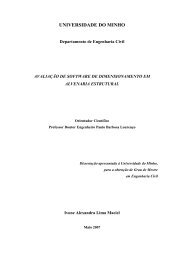

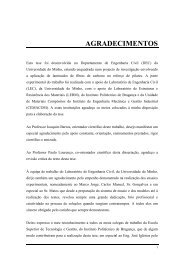

![Weibull [Compatibility Mode]](https://img.yumpu.com/48296360/1/190x134/weibull-compatibility-mode.jpg?quality=85)

